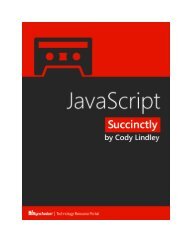JavaScript_Succinctly
Create successful ePaper yourself
Turn your PDF publications into a flip-book with our unique Google optimized e-Paper software.
Clearly, the value of this is based on the context in which the function is being called.<br />
Consider that both myObject.sayFoo and sayFoo point to the same function. However,<br />
depending upon where (i.e. the context) sayFoo() is called from, the value of this is<br />
different.<br />
If it helps, here is the same code with the head object (i.e. window) explicitly used.<br />
Sample: sample101.html<br />
<br />
window.foo = 'foo';<br />
window.myObject = { foo: 'I am myObject.foo' };<br />
window.sayFoo = function () {<br />
console.log(this.foo);<br />
};<br />
window.myObject.sayFoo = window.sayFoo;<br />
window.myObject.sayFoo();<br />
window.sayFoo();<br />
<br />
Make sure that as you pass around functions, or have multiple references to a function,<br />
you realize that the value of this will change depending upon the context in which you<br />
call the function.<br />
Notes<br />
All variables except this and arguments follow lexical scope.<br />
The this keyword refers to the head object in nested functions<br />
You might be wondering what happens to this when it is used inside of a function that<br />
is contained inside of another function. The bad news is in ECMA 3, this loses its way<br />
and refers to the head object (the window object in browsers), instead of the object<br />
within which the function is defined.<br />
In the following code, this inside of func2 and func3 loses its way and refers not to<br />
myObject but instead to the head object.<br />
Sample: sample102.html<br />
<br />
106



